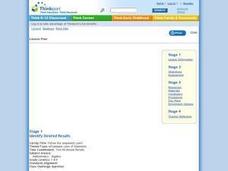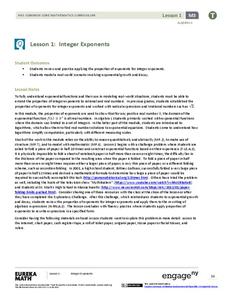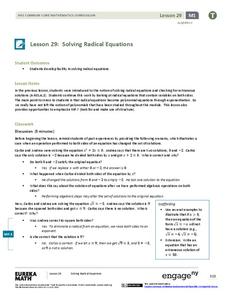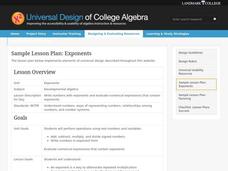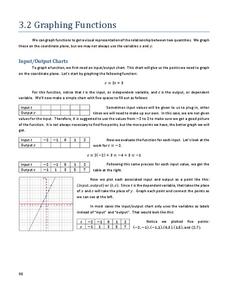Curated OER
Follow the (exponent) Laws!
Students participate in technology-rich activities with the common goal of strengthening Students' understanding of simplifying expressions that involve exponents. They work in heterogeneous groups to discover the laws of exponents.
Curated OER
Evaluate Using Power Rule
In this algebra learning exercise, students solve exponential logarithmic equations. They find the base or the exponent of the problem using logarithmic properties. There are 5 questions with an answer key.
Achieve
Spread of Disease
Viruses can spread like wildfire, and mathematics can model the speed of infection. Given a function, scholars analyze it to describe the spread of a disease within a stadium. Learners find the initial number infected and the maximum...
EngageNY
Mid-Module Assessment Task - Algebra 2 (Module 3)
The 15th installment of a 35-part module is a mid-module assessment task. Covering concepts in the first half of the module, the task acts as a formative assessment, providing you with valuable information on how learners are doing.
EngageNY
Integer Exponents
Fold, fold, and fold some more. In the first installment of a 35-part module, young mathematicians fold a piece of paper in half until it can not be folded any more. They use the results of this activity to develop functions for the area...
Inside Mathematics
Functions
A function is like a machine that has an input and an output. Challenge scholars to look at the eight given points and determine the two functions that would fit four of the points each — one is linear and the other non-linear. The...
Balanced Assessment
Catenary
Develop a model for a hanging chain. Pupils find a mathematical model for a hanging chain and then they compare their models to the precise function that models the curve. Scholars come up with a strategy to determine how close...
Mathematics Assessment Project
Representing Functions of Everyday Situations
Functions help make the world make more sense. Individuals model real-world situations with functions. They match a variety of contexts to different function types to finish a helpful resource.
EngageNY
Choosing a Model
There's a function for that! Scholars examine real-world situations to determine which type of function would best model the data in the 23rd installment of a 35-part module. It involves considering the nature of the data in addition to...
Concord Consortium
Rule of 72
Find an easier way to double it. Using the price of an item and the Consumer Price Index, learners determine how long it will be for the price to double. Scholars calculate the length of time it would take for the price to double using a...
EngageNY
The “WhatPower” Function
The Function That Shall Not Be Named? The eighth installment of a 35-part module uses a WhatPower function to introduce scholars to the concept of a logarithmic function without actually naming the function. Once pupils are...
Inside Mathematics
Two Solutions
Many problems in life have more than one possible solution, and the same is true for advanced mathematics. Scholars solve seven problems that all have at least two solutions. Then three higher-level thinking questions challenge them to...
EngageNY
Modeling from a Sequence
Building upon previous knowledge of sequences, collaborative pairs analyze sequences to determine the type and to make predictions of future terms. The exercises build through arithmetic and geometric sequences before introducing...
EngageNY
Solving Radical Equations
Learners solve complex radical equations. Solutions vary from one, two, and none, allowing pupils to gain experience solving a variety of problems.
Rice University
Algebra and Trigonometry
Move on into trigonometry. An informative eBook takes the content of a College Algebra course and adds more relating to trigonometry and trigonometric functions. The content organization allows pupils to build upon their learning by...
Curated OER
Exponents
Ninth graders solve problems involving exponential functions. In this algebra lesson, 9th graders apply their knowledge of exponential properties to add, multiply, divide and subtract exponential functions. They perform these operations...
Curated OER
Graphing Functions
For this graphing functions worksheet, students write functions in logarithmic and exponential forms. They evaluate logarithms and determine the inverse of a function. Students graph functions. This six-page worksheet...
Curated OER
Scientific Notation, Significant Figures and the Factor-Label Method of Solving Problems
In this scientific notation, significant figures, and factor-label method, students solve 1 problem where they perform mathematical functions and identify their answer in scientific notation with the proper number of significant figures....
Curated OER
Exponents and Radicals
For this exponents and radicals worksheet, students simplify 31 radical and exponent problems. Students rationalize denominators, multiply by conjugates, use exponent rules, and evaluate exponential and radical expressions.
Curated OER
Advising China
Students express their opinions about how growth and modernization affect nations. Reading an article on China, they discuss the causes and effects of exponential growth in a single town. They research how China has changed by writing...
Curated OER
Indices and Standard Form
In this algebra worksheet, students solve exponential and problems using exponential properties. There are 17 questions, with an answer key.
Curated OER
Modeling Natural Disaster with Mathematical Functions
Ninth graders investigate the functional relationship of different environmental phenomena. In this math lesson, 9th graders create models of various natural disasters. They use logarithmic and exponential functions to interpret...
Curated OER
Scientific Notation
In this algebra worksheet, 9th graders rewrite exponential numbers using scientific notation and condense the equations and expand using the standard form. There are 6 word problems applying the use of scientific notations.
Curated OER
Exercise Set 3.3: Laws of Logarithms
In this logarithms worksheet, students simplify and solve 100 logarithm problems. Students use logarithem rules to prove logarithm properties and simplify logarithmic expressions.
